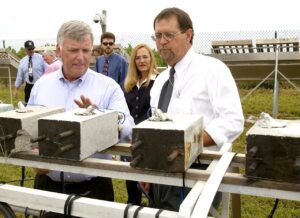Anti-Corrosion Coatings
Inducted In: 1995, Environmental and Resource Management
NASA has had requirements for anti-corrosion coating for use in many space-related applications. For example, one need was for a superior coating to protect gantries and other related launch structures at NASA’s Kennedy Space Center (KSC) in Florida. At coastal facilities where external structures are subject to the corrosive effects of ocean spray and fog, an effective anti-corrosion coating was important to protect the valuable hardware and substantially reduce maintenance costs. At KSC, an acceptable coating also had to be able to withstand the extremely hot exhaust and thermal shock created by rapid temperature changes occurring during space vehicle launching. Through a research program at NASA’s Goddard Space Flight Center in the 1970’s, scientists discovered that inorganic coatings formulated with zinc dust and potassium silicate produced a coating with improved corrosion resistance that fulfilled NASA criteria and reduced associated labor costs by providing long-term protection with a single application.
In 1981, NASA negotiated a license with Shane Associates for rights to the anti-corrosion material. Inorganic Coatings, Inc. signed an agreement with Shane to become the sole manufacturer and sales agent for the product. The commercial coating is a non-toxic water-based material that bonds well to steel and dries within 30 minutes to a ceramic-like, hard, durable finish. The product, IC 531 Zinc Silicate, has been utilized to coat bridge girders, pipelines, oil rigs, military tanks, dock equipment, buoys, municipal water facilities, power stations, antennas, tractor-trailer frames, and marine products to name a few. The most publicized application was the 225 gallons applied to the wrought iron interior of the Statue of Liberty during refurbishing. It has also been used to paint the interior structure of the huge statue of Buddha.
Related Technologies

Sewage Treatment With Water Hyacinths
Inducted In: Environmental and Resource Management
For more than a decade, NASA's laboratories conducted research on the use of water hyacinths for treating and recycling wastewater for application in space colonies and long duration manned space flights of the future. Researchers discovered that water hyacinths thrive…

Fabric Roof Structures
Inducted In: Environmental and Resource Management
In the late 1960s, NASA's Johnson Space Center went searching for a lightweight, non-combustible fabric durable and strong enough to protect the astronauts in an alien, zero-gravity environment. One American company, Chemical Fabrics, a specialty weaver and coater, was already…

Heat Pipe Systems
Inducted In: Environmental and Resource Management
In the early days of NASA's space research, there was concern over problems of temperature control of non-rotating satellites. The side facing the sun would build up excessive heat, and the opposite side would become very cold, thus a serious…

